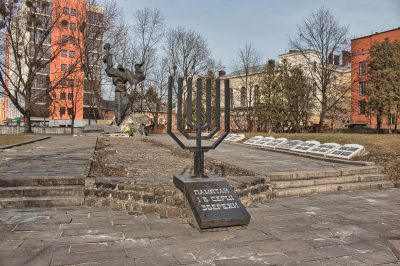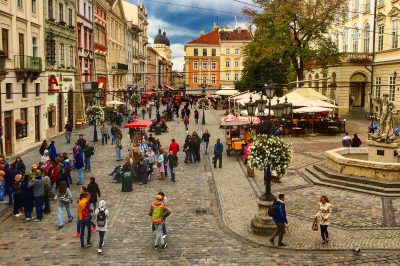Lviv was once one of the most important cities in Jewish Eastern Europe. More than a third of the population, and thus over 100,000 people, were Jews before World War II nearly wiped out the city’s Jewish community. Today, only about 1,500 Jews remain in Lviv. Nevertheless, some of them, and increasingly foreign Jews with roots in Lviv, are recalling this long tradition. Today, in addition to many historic sites, there is once again a small Jewish Lviv, with a tentatively growing cultural life.
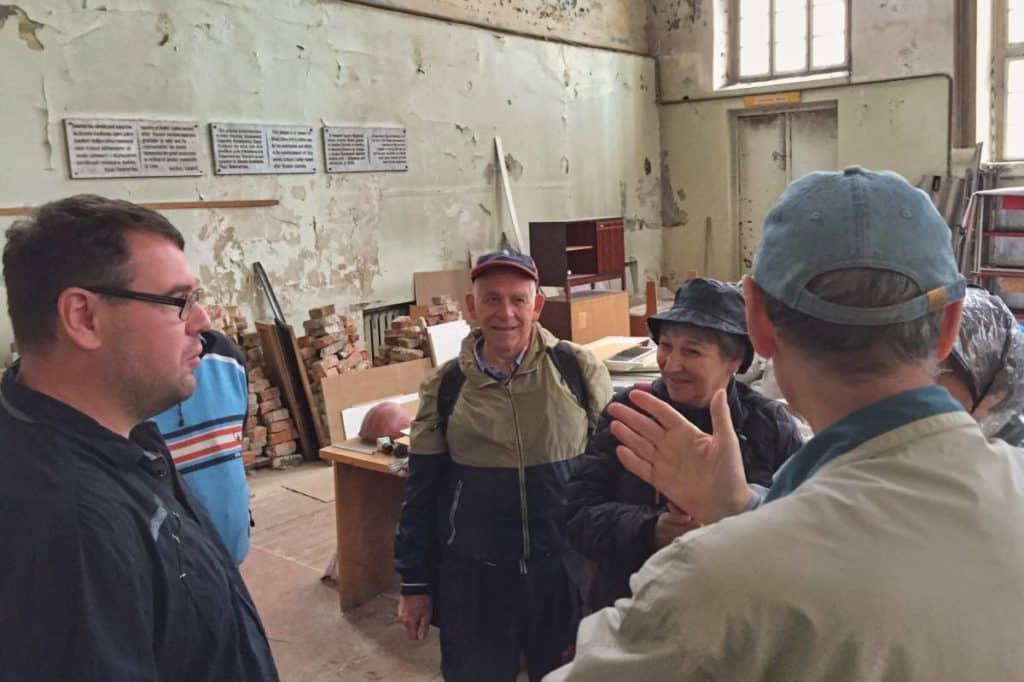
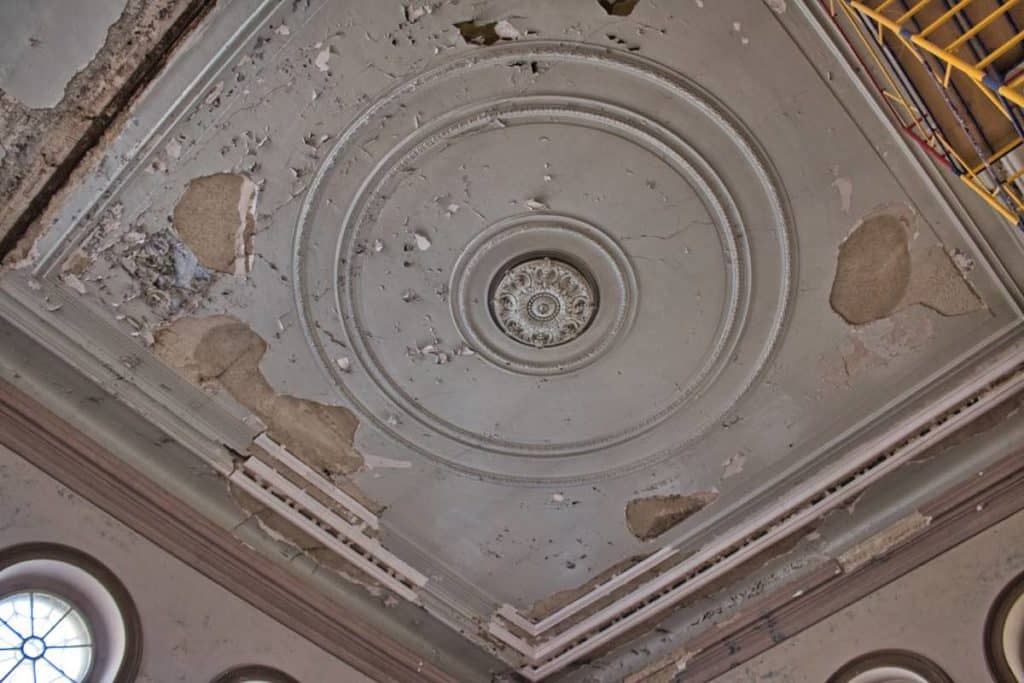
The Jakub Glanzer Shul is alive again
In the middle of the large hall of the former Jakub Glanzer Schul, Sasha Nazar stands watching a French volunteer pour plaster into a molded shell. “This is Remi from France. He’s helping us restore the stucco on the ceiling of the synagogue.” Sasha Nazar is making sure the synagogue doesn’t fall into further disrepair. Once the Glanzer Shul was one of more than 40 synagogues in Lviv. Today, only two of them have been preserved and are also used as Jewish places.
Sasha Nazar has many projects. He is also making sure that the Brody synagogue does not fall into further disrepair. But most of his attention belongs to the Glanzer Shul. “We would like to reestablish a truly open cultural center here,” he says. There should be concerts with international bands. Already there is an exhibition on the lost synagogues of Lviv. Before the Corona pandemic, several hundred visitors came to the exhibition every month. Currently, it is rather quiet in the building. “But this has good sides, too. So we can concentrate on the work,” says Sasha Nazar.
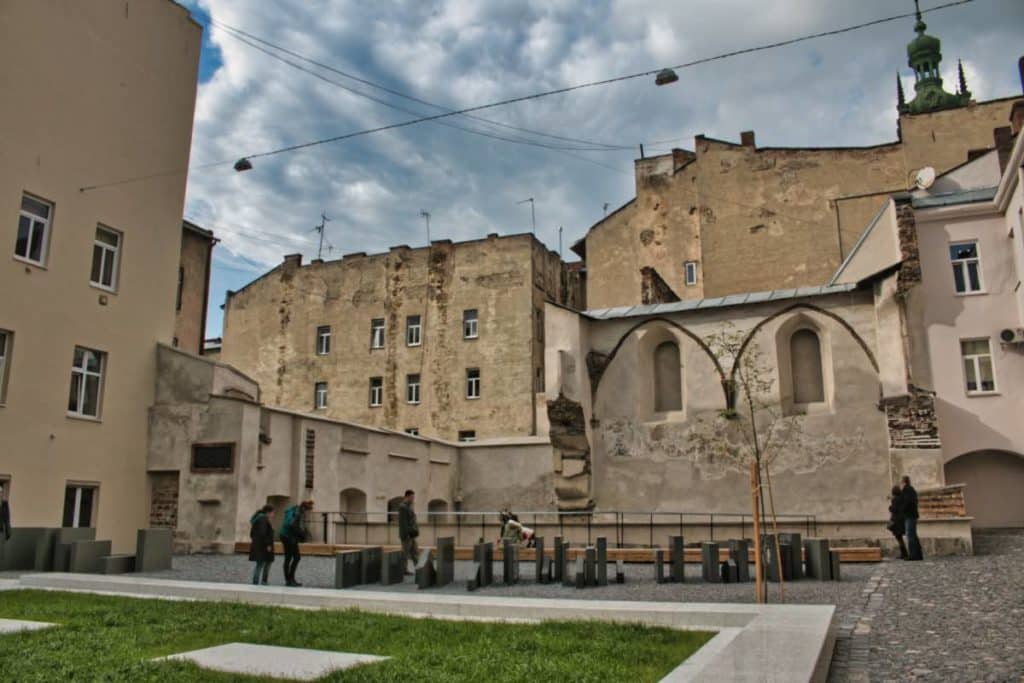
Golden Rose Synagogue – ruin in the heart of the city
And work is also sorely needed in Lviv. Because the German hate has left many gaps in the city. The most famous and visible memorial to the Holocaust in Lviv is the ruin of the Golden Rose Synagogue. The Golden Rose was the most famous synagogue in the city. Eminent rabbis taught here and helped the city gain a reputation in the Ashkenazi world. In 2016, after all, a memorial to the Holocaust was built here, making the area accessible again. The Lviv Center for Urban History has redeveloped the area. Now visitors can at least get an idea of the central place this Jewish temple once occupied.
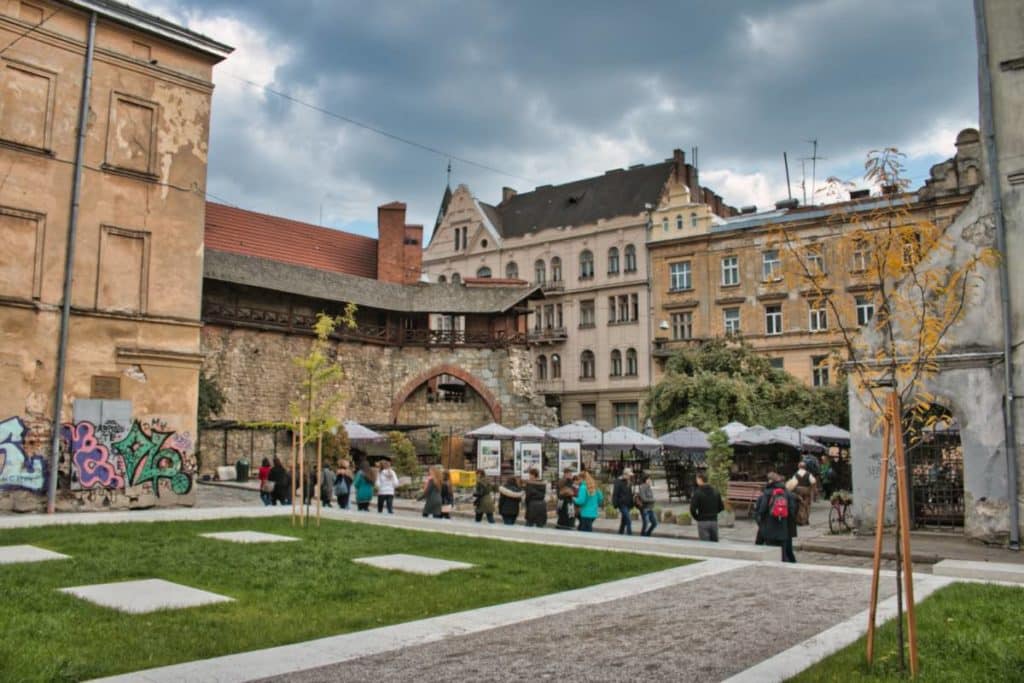
Next to it also stood a Beit Midrash and the Great Central Synagogue, the most important temple in the Old City. All these buildings were destroyed by German soldiers and their collaborators during the Holocaust. The Jewish population of the city was also systematically annihilated. Of once over 110,000 Jews, it is estimated that only 2,000 to 3,000 survived the Shoah – in other words, probably more than 98 percent of the city’s Jews were murdered. Almost unimaginable.
Museums and theaters testify to the Jewish culture of Lviv
Many people are hardly aware of what cultural treasures and the memories of them were lost, both materially and humanly. Buildings like that of the former Jewish community remain empty to this day. The building once also housed the Jewish Museum. Until 1939, the collection displayed the treasures of the city’s Jewish history, which spanned more than 600 years. After all, most of the collection was hidden from the Nazis and Soviets and survived the years in an attic and a basement. Just in 2019, parts of it were shown in an exhibition at the Lviv Ethnographic Museum. There is still no permanent place to exhibit it.
Also in the neighborhood of the museum stands to this day the last building in which Gimpel’s Theater was active. The Gimpel family theater, today the First Ukrainian Children’s Theater, was a Yiddish-speaking stage, where even artists were trained who later stood on the Yiddish-speaking stages of Warsaw or New York.
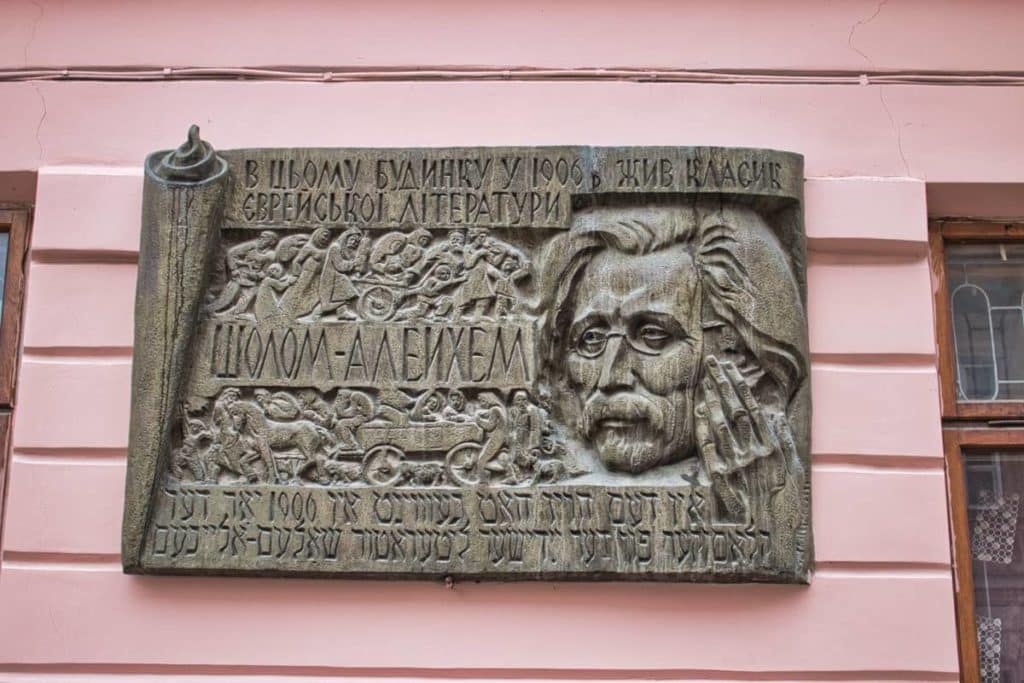
Famous Lviv Jews keep the memory alive
And the city was also home to other Jews of world fame. Sholem Alecheim, for whom there is now a commemorative plaque on Vulitsa Kotliarska, lived here and wrote a number of plays before providing writing Anna Tevka which served as script for the musical “Fiddler on the roof”. The Polish-Jewish science fiction writer Stanislaw Lem grew up in the city’s middle-class Jewish neighborhood and described his childhood in the autobiographical work “High Castle,” named after the former castle Lviv High Castle. He survived the Holocaust with forged Polish papers and later became world famous for his work “Solaris”.
Simon Wiesenthal, known after the war as Nazi hunter for pursueing Nazi war crimonals, also survived the Shoah in Lviv. He worked as an architect in the city before the war. Less fortunate was the poet Debora Vogel, who wrote her prose in Yiddish. She was murdered in the Lemberg ghetto with her husband and five-year-old son. Recently, however, a comprehensive volume of poetry with her works was published in Yiddish and German, which also keeps her memory alive.
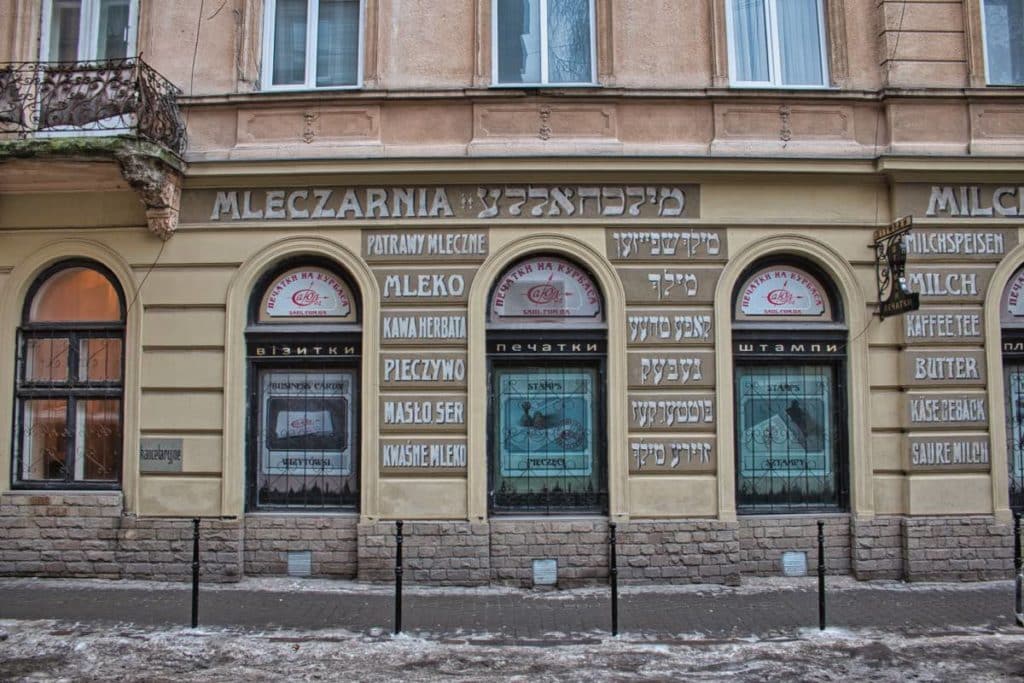
Jewish ghost signs remind of the busy commercial life
Strolling through the alleys of the Ukrainian city, one not only sees the legacy of the 140 years that the city was part of Austria and later Austria-Hungary. You also notice the many ghost signs that once served as advertising signs for stores located there. They bear witness not only to the hustle and bustle of the city, but also to the multicultural past of Lviv, which had its own name in each language: Lemberg in German, Lwów (pronounced Lvoov) in Polish, Lviv in Ukrainian, Lemberik in Yiddish, Leopolis in Latin. Fortunately, many Lviv citizens are aware of this heritage and expose and preserve it.
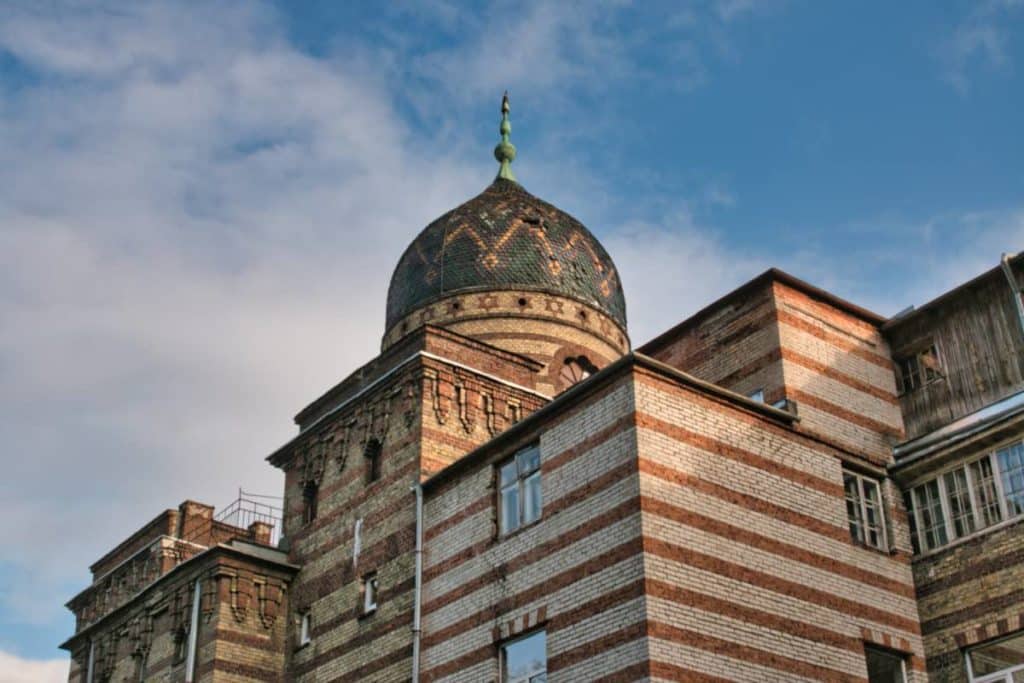
Invisible heritage of the Lviv Jews
Sometimes, however, while the heritage is present and well preserved, citizens are hardly aware that these are even buildings that Jews had erected. For example, the entire Freedom Avenue (Prospekt Svobody) is actually populated with buildings that once belonged to Jews. These include the Sprecher House on Adam Mickiewicz Square, which was Lviv’s first high-rise building. Jews also built the former Galician Savings Bank building, which now houses the Ethnographic Museum, as well as the building of the bank right next to it, which also once belonged to a rival Jewish bank.
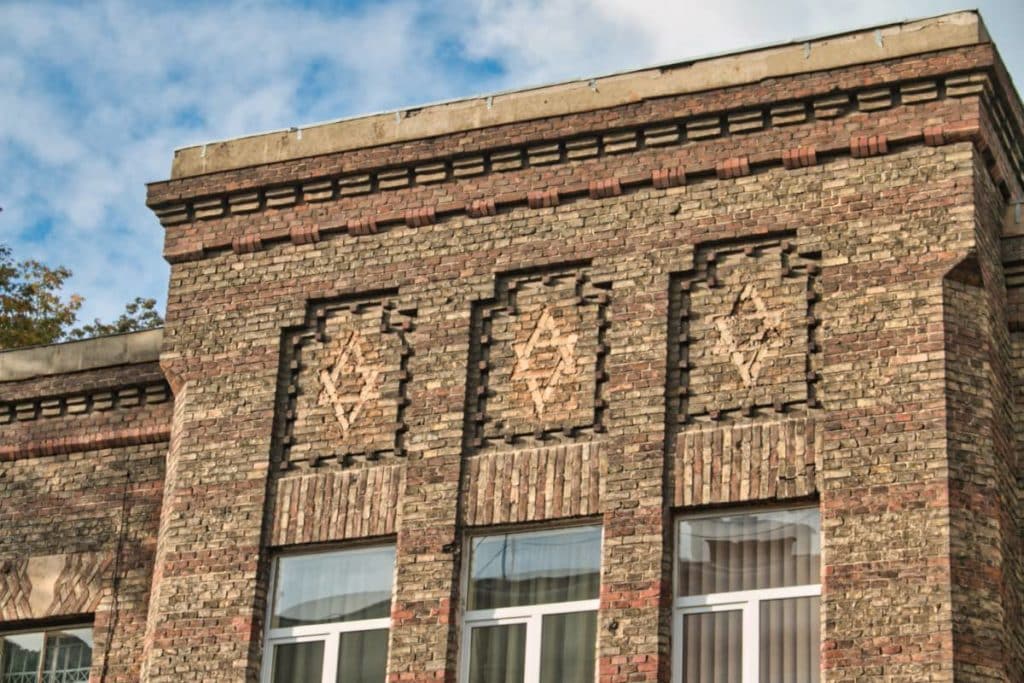
On Rappaport Street, the former Jewish hospital also stands to this day. Fading Hebrew and Polish letters can still be seen on the facade, indicating the Bet Shulim Hospital. At the turn of the 19th and 20th centuries, it was the most modern hospital in the city. Non-Jews were also treated here. After all, the building is a hospital even to this day. In the maternity hospital No. 2 many Lviv citizens are born.
Joy and sorrow lie close together in Jewish Lviv
But even next to this place of joy there are the memories to the crimes that took place here during the Second World War. Behind the hospital there is a small park. A memorial stone erected there commemorates the Old Jewish Cemetery of Lviv, which was located here. It was desecrated by the Nazis and finally destroyed by the Soviets after the war. In 1947, the Krakow Market was built on parts of the area, which is still the largest market in the city.
Even today, gravestones from this and other cemeteries are found during construction work, and volunteers then move them to the New Jewish Cemetery at Janowski Cemetery. During desecrations, Nazis or Soviets had stolen the stones and used them for road construction. Given the former size of the Old Jewish Cemetery, some streets must still be paved with them.
Traces of the horror in the Lviv Ghetto
The Jewish hospital was also part of the city’s ghetto after the occupation of Lviv by German troops. As of November 1941, the so-called Jewish residential district housed more than 150,000 Jews from Lviv and Jews who had fled from the territories already occupied by the Germans in 1939. Conditions in the Lviv Ghetto were catastrophic. However, due to constant arrests, deportations to the Belzec extermination camp, shootings and starvation, the area of the ghetto was constantly reduced. In the end, only a few streets remained in the Pidzamche neighborhood, which was then dissolved in the fall of 1943.
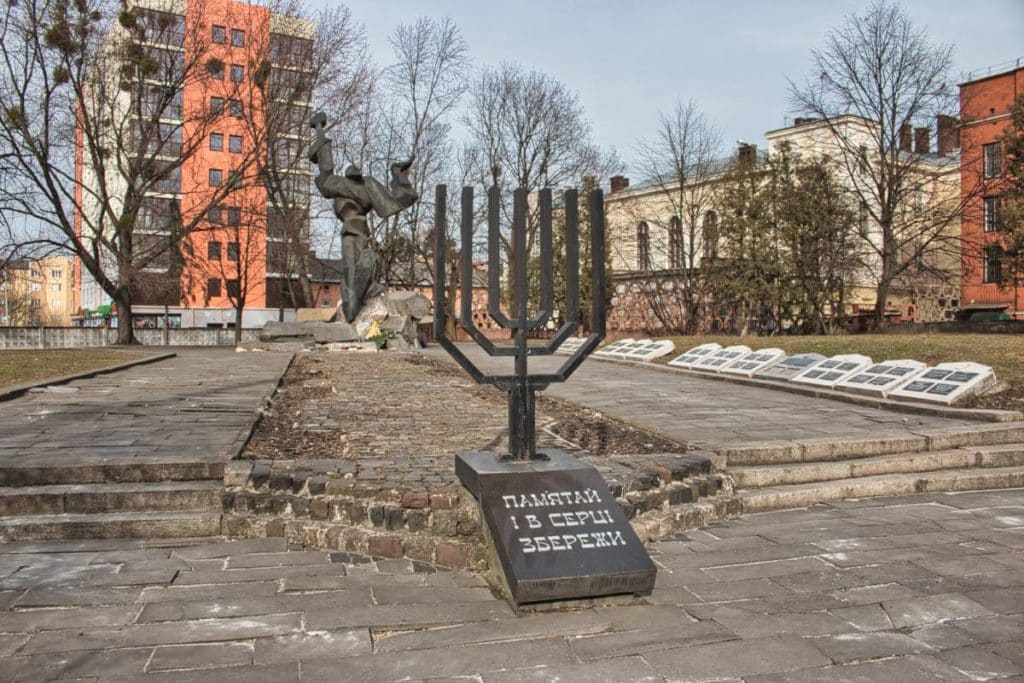
In this neighborhood today stands the Ghetto Memorial, erected in 1992 and designed by Lviv Holocaust survivor Luisa Sternstein. Wreath-laying ceremonies commemorating the fate of ghetto Jews are also held here every year. Across the street, the Territory of Terror Museum organizes exhibitions commemorating the suffering in the ghetto and other places of German and Soviet occupation of Lviv. The team of young researchers puts together exhibitions about the Holocaust in Lviv and also provides information, for example, about the Janowska concentration camp.
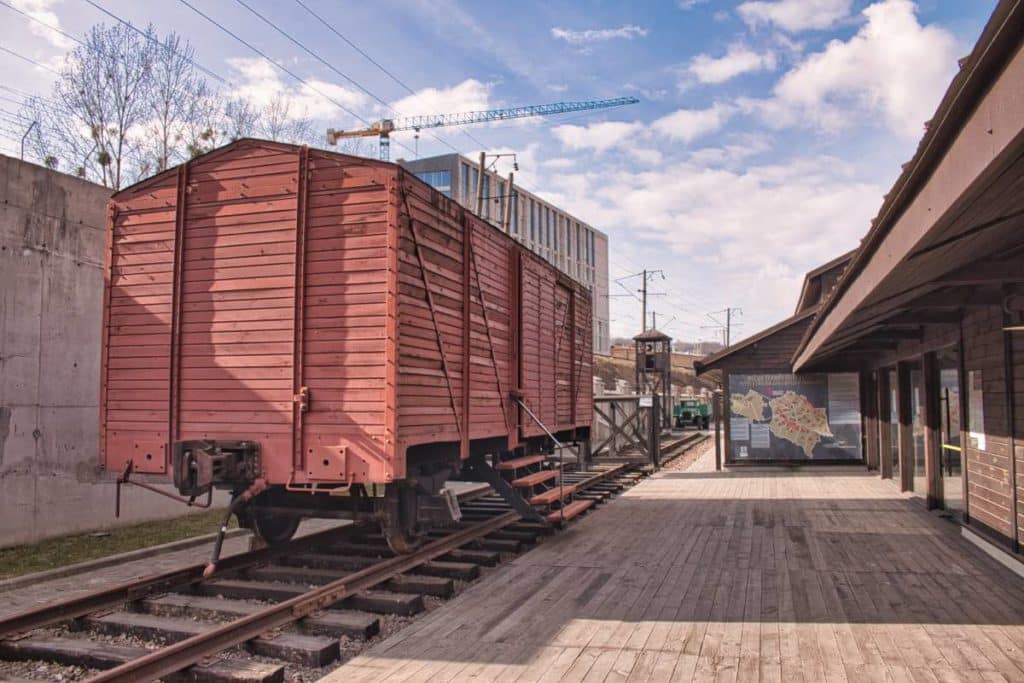
Memorial at the Janowska Concentration Camp in Lviv
Janowska is one of the places where Jewish Lviv suffered the most. There is now also a memorial to the victims of the concentration camp on the site of the former Janowska concentration camp. Unfortunately, to this day, even 77 years after the liberation, there are no signs or design of the site as a Holocaust memorial.
Part of the problem is that partial areas of the former camp are built on by a prison to this day and continue to be used. However, at least in the sand pits that are accessible, there should be signs. It is estimated that more than 50,000 Lviv Jews were murdered here. For this huge number, the commemoration is far too inconspicuous and in the city’s consciousness the murder site is hardly present. Only a few Lviv citizens know about the history of the site.
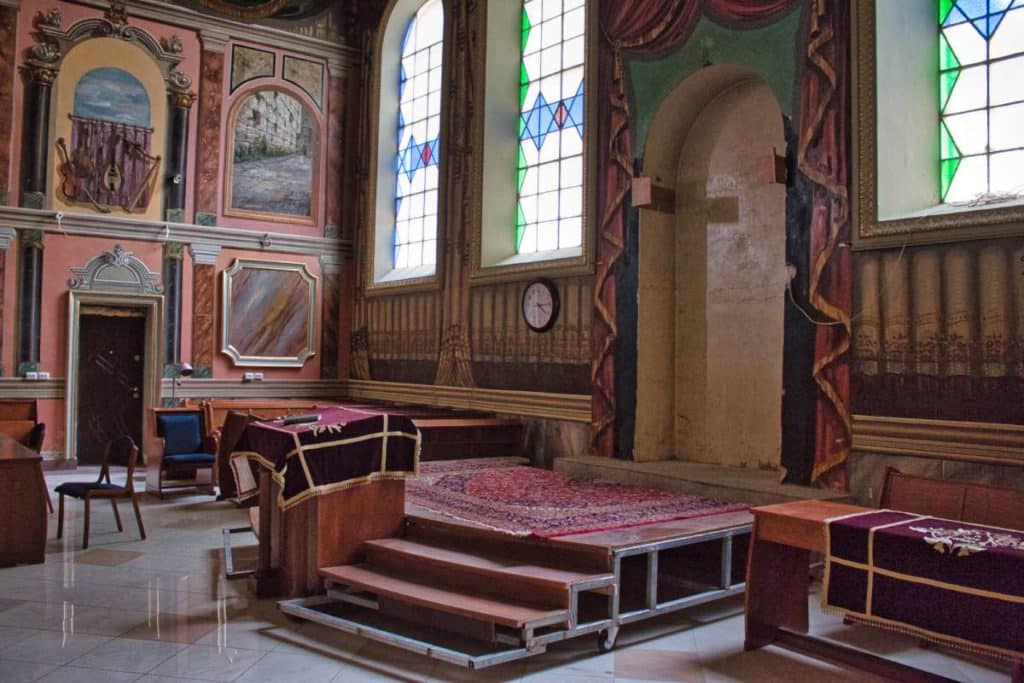
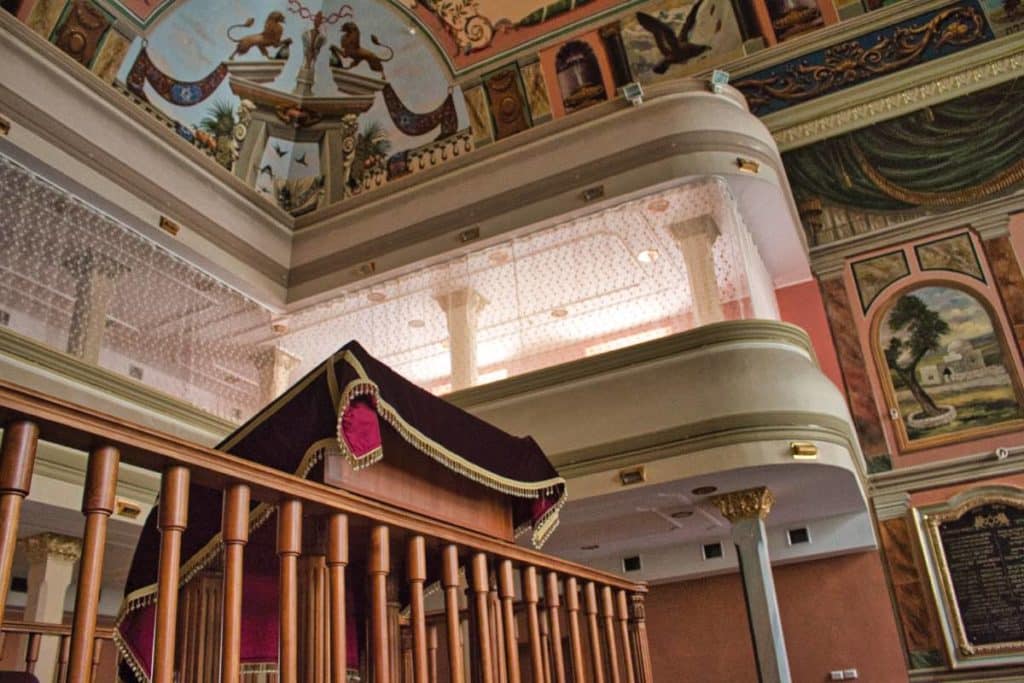
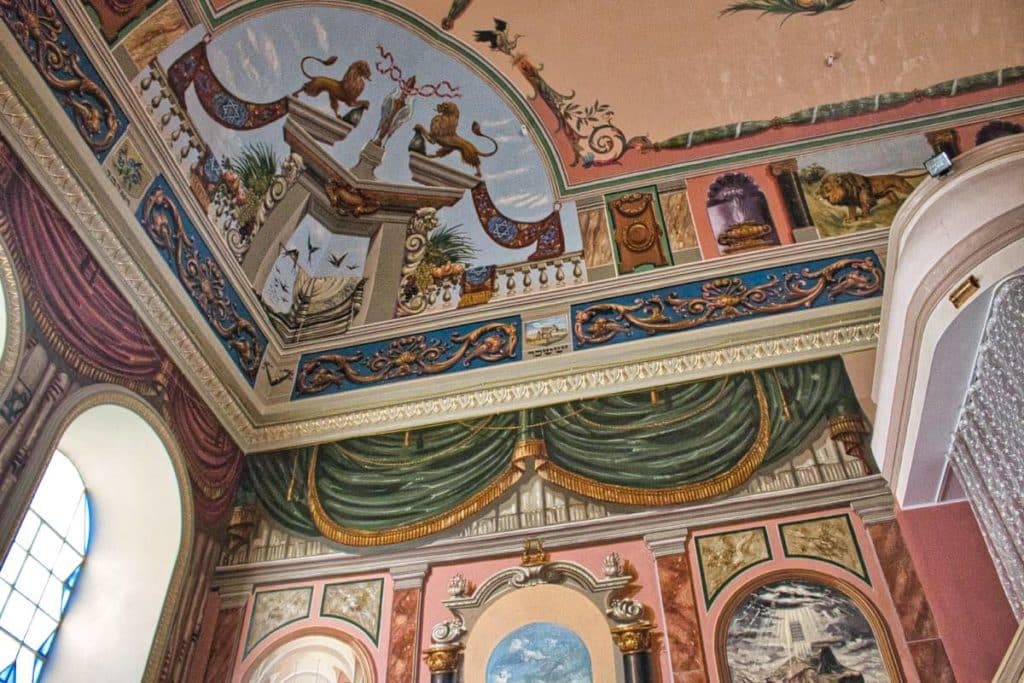
Religious life in the Tsori Gilod Synagogue
The fact that there is nevertheless once again a Jewish Lviv that lives and breathes is also thanks to Jews who have resettled in Lviv. In Soviet times, the Jewish community had once again revived and there were up to 20,000 Jews in the city, who came here mainly from other parts of the then Soviet Union. But many emigrated to Israel, the United States, or even to the country of the perpetrators, Germany. After Ukraine became independent, the Jewish community of Lviv had again shrunk considerably.
Nevertheless, a few Jews from the USA came to take care of the heritage of Jewish Lviv. Among them is the family of Rabbi Morchechai Bald and his wife, who take care of the Tsori Gilod Synagogue. Those who ring the bell here can look around the synagogue designed by Maximilian Kugel and also ask their questions about Judaism and Jewish life in Lviv.
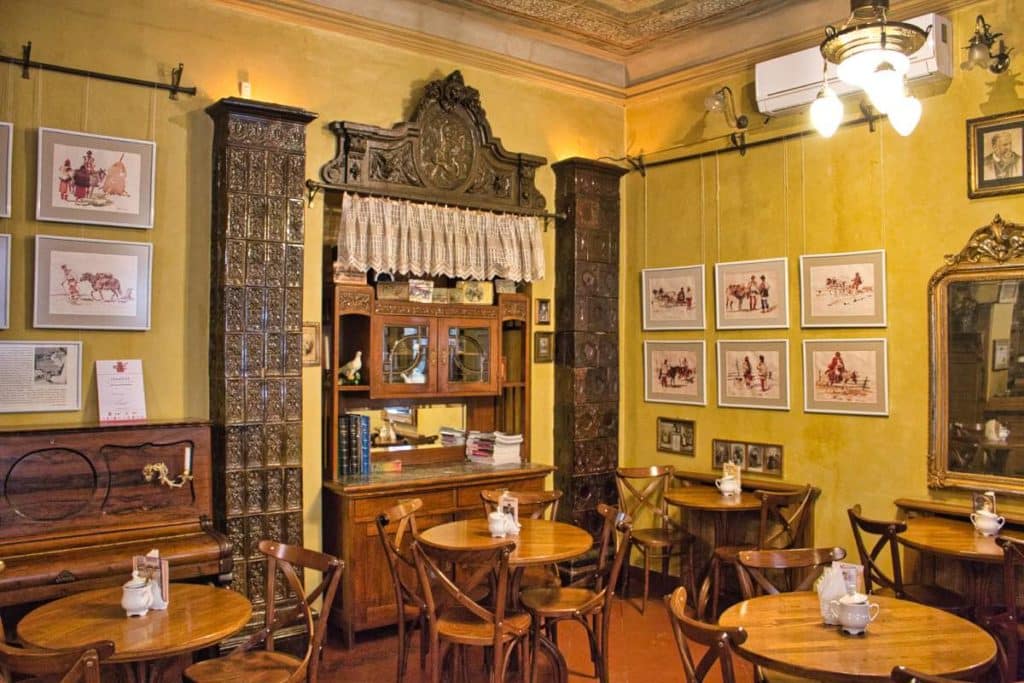
Jewish food and drinks in Lviv
And it is not only by asking questions that Jewish Lviv can be experienced today. Café Jerusalem near the famous Lviv Lychakiwski Cemetery serves food from Jewish culture. Thus, in addition to Ashkenazi dishes such as gefilte fish, there are Sephardic dishes like hummus and falafel. The Jerusalem is the only restaurant so far that is run by Jews and offers Jewish food. Nevertheless, Jewish food is also served in restaurants like the Baczewski.
For dessert we were to go to Café Sztuka. On the facade of the house, advertising for a Jewish grocery store can still be seen in Yiddish and Polish. Inside, there are portraits of Emperor Franz Joseph I as well as signs from a yeshiva and references to the city’s Jewish heritage. Occasionally, even Kleszmer music evenings are held here. And so visitors can then also hear the Jewish heritage of Lviv.
Tours of Jewish Lviv
There are some companies that now offer city tours and tours of Jewish Lviv. However, I myself am the owner of a company for city tours and we offer tours through Jewish Lviv, as well as on the history of the Holocaust and in cities in the surrounding area with a rich Jewish history such as Brody or Drohobych. Therefore, you can get more info about the city tours and a direct contact with the author of this post at Lviv Buddy.
More on the topic online
There are great initiatives to research the topic. Particularly noteworthy are:
- Vanished World Blog – Christian Herrmann posts photos of his travels through Holocaust-affected countries on his blog, highlighting the disappearing traces of the region’s Jewish past.
- Lviv Center for Urban Studies – The Lviv Center is concerned with the study of urban space and has also contributed much to the preservation and study of Jewish Lviv. A visit to the site shows the various commemorative projects.
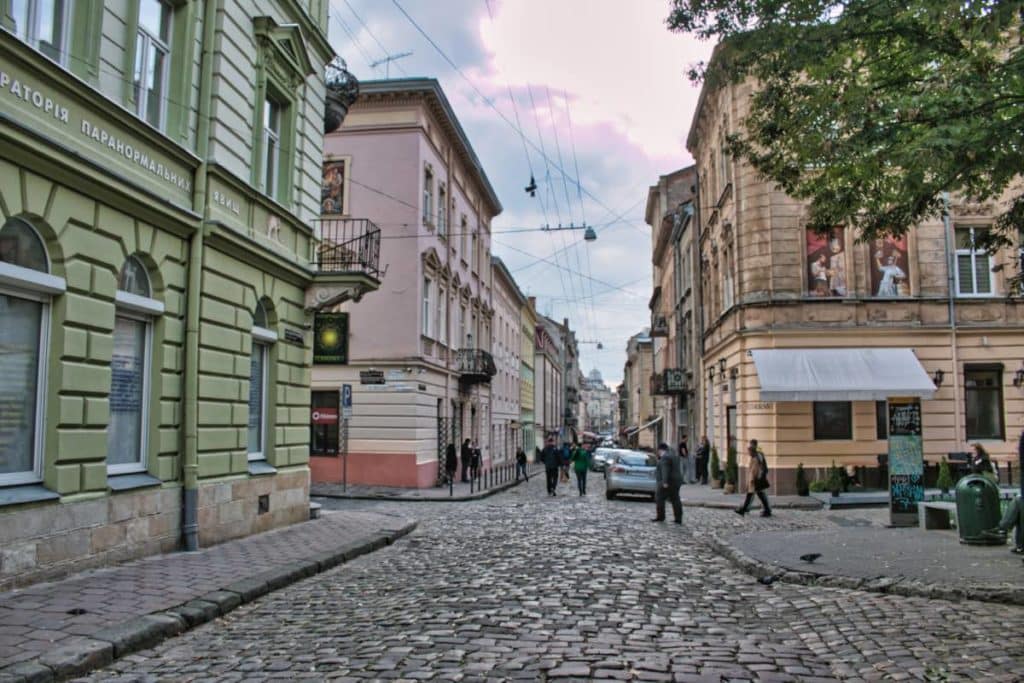
Book tips about Jewish Lviv
In recent years, however, Jewish Lviv has once again become the focus of authors. Therefore, there are quite a few interesting books that can prepare you for a trip to Lviv.
East West Street
In his book East West Street, British author Philippe Sands describes how the two Lviv residents Raphael Lemkin and Hersch Lauterpacht coined the terms “crimes against humanity” and “genocide”. He simultaneously paints a moving portrait of Lviv at the time of the Second World War and of the two protagonists, who went through a highly divergent development.
- Sands, Philippe (Author)
My Lvov
Holocaust survivor Janina Hecheles describes how she and her family hide in the sewers of Lviv and therefore survive the Holocaust this way.
- Hescheles, Janina (Author)
Tango of Death
The writer outlines the story of another Holocaust survivor from Lviv who survive the Shoah as a violin player.
- Mintz, Dmitry (Author)
City of Lions
Philippe Sands wrote an account of the City of Lions as it was in 2016 just after the Revolution of Dignity.


